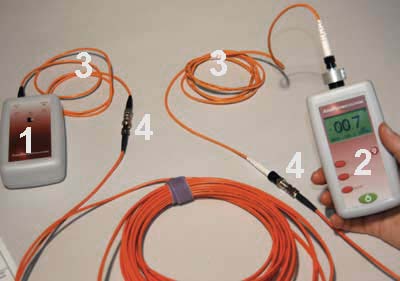A advanced optical fibre diameter analyser ensures fibre manufacturing.
Discovering the Benefits of Optical Fiber Examining for Improved Communication Equipments
The relevance of optical fibre testing in modern communication systems can not be overemphasized, as it works as a foundation for ensuring network integrity and efficiency. Utilizing innovative methods such as Optical Time-Domain Reflectometry (OTDR) and insertion loss analysis, companies can not only identify mistakes but additionally enhance their configurations. This positive testing strategy has profound implications for signal high quality and operational performance, raising the inquiry of how these techniques add to lasting sustainability in an ever-evolving technological landscape. Recognizing these dynamics is vital for stakeholders intending to preserve an affordable edge.
Importance of Optical Fibre Screening
The relevance of optical fibre testing can not be overemphasized in today's data-driven setting. As organizations progressively rely upon high-speed data transmission for everyday operations, the honesty and performance of optical fibre networks are vital. Examining ensures that these networks can support the large quantities of information created and transmitted seamlessly, promoting effective communication and connection.
Optical fiber screening offers numerous critical functions, including verifying installation quality, identifying possible mistakes, and identifying total system efficiency. Normal screening can protect against pricey downtimes and solution disturbances, permitting companies to preserve operational continuity. It aids in conformity with sector standards and guidelines, making sure that fibre optic installations fulfill needed specs for safety and reliability.
In addition, testing can enhance the long life of fiber optic systems. By proactively determining concerns such as signal loss, depletion, or port failures, companies can attend to issues prior to they rise, therefore expanding the life of their framework. In summary, optical fiber testing is not merely a technological need however a strategic financial investment that enhances network integrity, enhances efficiency, and eventually supports the development and effectiveness of modern-day communication systems.
Trick Checking Methods

OTDR is an important strategy used to determine mistakes, measure splice losses, and analyze the total stability of a fiber optic web link. By sending out a pulse of light down the fibre and assessing the reflected light, service technicians can pinpoint locations of faults and examine the network's efficiency over long distances.
Insertion loss testing determines the quantity of signal loss that takes place when light passes through a connection or splice. This technique is critical for confirming that connections satisfy given loss limits, which is crucial for maintaining ideal efficiency in interaction systems.
Optical return loss screening evaluates the quantity of light reflected back towards the source due to flaws in the fibre or connections. High return loss values suggest much better performance and lowered signal degradation.
Together, these testing methods provide an extensive analysis of fibre optic networks, ensuring their reliability and functionality in varied interaction applications.
Effect On System Efficiency
Reliable optical fiber testing directly influences the overall performance of communication systems. By guaranteeing the integrity of fibre optic cables, screening recognizes prospective faults such as attenuation, splice loss, why not find out more and adapter imbalance. These concerns can significantly degrade signal top quality, bring about disturbances and reduced data transmission rates.

In addition, routine optical fiber testing adds to long-term system sustainability. It makes it possible for early discovery of wear and tear, permitting for timely maintenance and upgrades prior to major failings take place. This not only lengthens the lifespan of the framework however also makes sure that interaction systems remain affordable in regards to performance.
Cost-Effectiveness and Effectiveness
Cost-effectiveness is an essential factor to consider in the deployment and maintenance of optical fiber networks. Executing durable optical fiber screening procedures can substantially lower operational expenses by recognizing concerns before they intensify right into significant troubles. fibre testing equipment. By detecting faults, attenuation, and other efficiency limitations early, companies can avoid costly repair work and downtime, which can interrupt solutions and bring about revenue loss
Additionally, effective screening methods improve the installation procedure, permitting service technicians to work more properly. This equates to lower work expenses and faster project conclusion times. Advanced testing tools, such as Optical Time try this website Domain Name Reflectometers (OTDRs), enables an accurate assessment of fibre top quality, making sure that only optimum materials are made use of, consequently minimizing waste.
Normal testing additionally contributes to far better resource appropriation. By recognizing the network's performance, organizations can make educated decisions regarding upgrades and expansions, making sure that investments are made where they are most needed. In summary, optical fiber testing enhances cost-effectiveness and effectiveness, sustaining the long-lasting sustainability and competition of communication systems in a progressively demanding market.
Guaranteeing Long-Term Integrity
Implementing extensive optical fiber testing not just enhances expense savings and functional performance however additionally plays a critical duty in guaranteeing the long-lasting integrity of communication networks. Constant screening techniques, including depletion and bandwidth evaluations, assistance recognize potential deterioration in fibre performance before it brings about service interruptions.
By utilizing sophisticated screening methodologies, network operators can pinpoint faults or weak points in the fiber framework, permitting for timely remediation. This proactive method lessens downtime, making certain that interaction systems remain functional and efficient. Additionally, routine testing contributes to the advancement of a much more durable network, as operators can adapt and enhance their facilities based on real-time data insights. fibre testing equipment.
Furthermore, making sure compliance with industry standards through optical fiber screening strengthens the high why not look here quality and stability of the entire communication system. This adherence not just boosts confidence among stakeholders but additionally straightens with regulative demands, which are increasingly stringent.
Conclusion
In verdict, optical fibre testing serves as an essential component in improving interaction systems. By employing different screening methods, such as OTDR and insertion loss evaluations, networks can attain optimal efficiency and integrity.